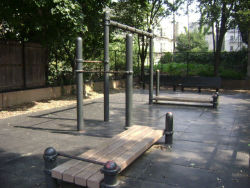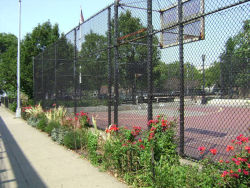Thomas Boyland Park
Boyland Park
This park is named to honor Thomas Boyland (1942-1982), a charismatic and fiercely independent State Assemblyman from Brownsville who dedicated his life to public service. Boyland was born in Memphis, Tennessee, one of thirteen children. He graduated from Philander Smith College in Little Rock, Arkansas, and studied in graduate programs at Hunter College and Syracuse University before receiving a master’s degree in education from New York University. During the 1960s, Boyland spent nearly five years in East Africa working as a volunteer with the Peace Corps.
In 1976, Boyland ran for the State Assembly in Brownsville against a candidate backed by Sam Wright (1925-1998), a City Councilman who at the time was a powerful leader of a political machine. To the surprise of many, Boyland won the election, and was reelected in 1978 and 1980 by overwhelming margins. Boyland’s popularity among voters was based on delivering services to individual constituents, setting an agenda independent of Assembly leaders, and advocating for the less fortunate. One friend said of Boyland, “He became one of those rare politicians who really delivered services to his constituents in Brownsville and East New York on a one-to-one basis, whether it was cleaning a vacant lot or dealing with agencies about individual complaints.” In 1982, the Assemblyman died in his sleep of a heart attack at the age of 39 while attending a national conference of African-American legislators in Hilton Head, South Carolina. This park was named in his honor when it opened in 1986. Thomas Boyland’s legacy lives on through his daughter, Tracy L. Boyland, who was elected in 1997 as a City Council Member from Brooklyn’s 41st District, and through his brother, William Boyland, a long-time State Assemblyman.
One of the original six towns of Brooklyn, Bushwick comes from the Dutch word “Boswijck,” meaning “refuge in the woods” or “heavy woods.” Chartered by Peter Stuyvesant (1610-1672) in 1661, Bushwick was settled in the 19th century by tobacco and grain farmers from France, Scandinavia, England, and Holland. By the mid-1800s, Bushwick boasted eleven breweries on a fourteen-block stretch known as “Brewer’s Row.” Businessman and onetime presidential candidate Peter Cooper (1791-1883) built his first glue manufacturing factory here in the 1840s, joining already established sugar, chemical, and oil industries in the area. The subdivision of farms begun by Adrian Martenses Suydam in 1869 led to a population growth that gained momentum after 1888, when railway access made for an easy commute to Manhattan.
Boyland Park is located near the historic Cemetery of the Evergreens. The cemetery opened in 1849, and is the permanent resting place of dancer Bill “Bojangles” Robinson (1878-1949) and New York Governor Samuel J. Tilden (1814-1886), among others. Many of the victims of the Triangle Shirtwaist Factory fire of 1911 are buried here, and a monument in the cemetery remembers the victims of the tragedy. There are approximately 800 actors buried at Cemetery of the Evergreens, and the Actors Fund Memorial, a tall spire structure, was erected here in 1887.
Boyland Park was transferred to Parks on August 2, 1985 from the Department of Housing Preservation and Development, which had deemed the site inappropriate for housing, due to the nearby elevated train. The park contains a baseball field, handball and basketball courts, play equipment with safety surfacing, game tables, a spray shower, and a flagpole with a yardarm. In 1996, the park received a $375,000 renovation, funded by Borough President Howard Golden, which added security lighting and refurbished existing equipment.
Check out your park's Vital Signs
Clean & Safe
Green & Resilient
Empowered & Engaged Users
Share your feedback or learn more about how this park is part of a
Vital Park System





